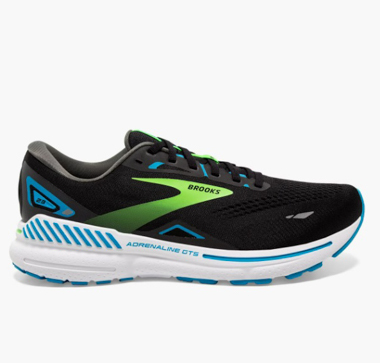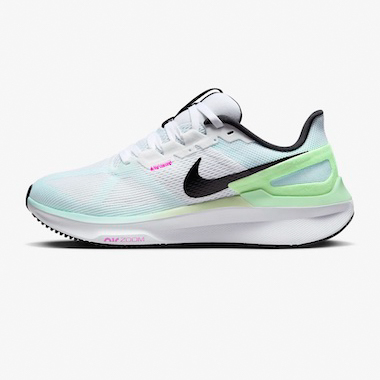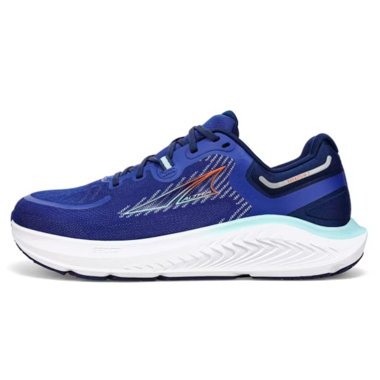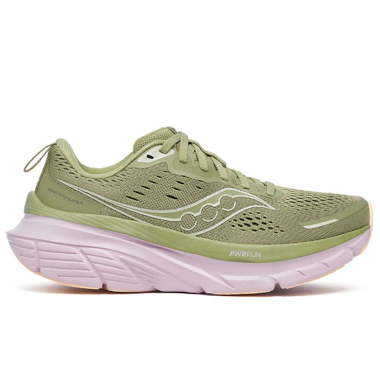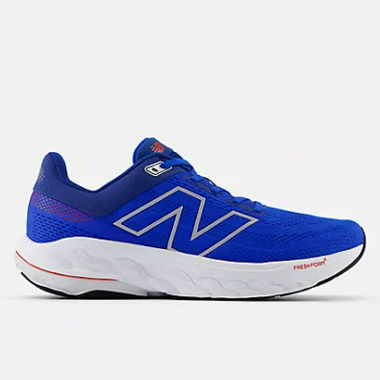
Stability shoes are an excellent road running option for overpronators. Photo: iRunFar/Eszter Horanyi
For most of us, the foundation of a long and healthy lifetime of running starts with our shoes. Running shoes that fit correctly, feel comfortable, and provide the right support for your unique running gait will help keep your feet and legs healthy and happy, and the best stability running shoes can help an overpronator stay injury-free.
Stability shoes are an excellent option for people with low arches that collapse, those with flat feet, or those who spend much of their time running on roads. Visiting a specialty running store and having an employee analyze your gait and arches can help determine if you could benefit from stability shoes.
If you’re here because you already know you want stability road running shoes and need help choosing between many styles, we’ve narrowed down a list of the best based on extensive research and testing. Our team of runners of all sorts looked at the top stability shoes on the market and tested two dozen of them over hundreds of miles so that we could compile a list of our top picks.
Since initially publishing this guide in 2023, we have continued to test new models, updating the guide as they become available. We continue to love the high level of structure offered by the Brooks Adrenaline GTS 23, while we turn to the Nike Structure 25 when we need a bit of extra support for our gait.
Below, find additional buying advice, answers to frequently asked questions, and a list of common running terminology. See our testing methodology below to learn how we chose our top picks.
Finally, if you’re looking for everyday neutral road running shoes, cushioned road running shoes, or trail shoes, we’ve got guides that can help you with that, too.
Best Stability Running Shoes
Best Overall Stability Running Shoe: Brooks Adrenaline GTS 23
Best Stability Running Shoe — Runner-Up: Nike Structure 25
Other Great Stability Running Shoes: Altra Paradigm 7, Saucony Guide 18, New Balance Fresh Foam X 860v14

Co-author Alli Miles tests a pair of stability shoes during a morning run. Photo: iRunFar/Eszter Horanyi
Best Overall Stability Running Shoe: Brooks Adrenaline GTS 23 ($140)
Pros:
- Great stability support
- Comfortable upper
- Breathable
Cons:
- It can feel too stiff out of the box
- Not as springy as other top picks
It’s no wonder our testing team rated the Brooks Adrenaline GTS 23 as the best stability running shoe. It’s been a favorite among runners for more than twenty years. The shoe provides a balance of cushion and support with a traditional shape and fit that works well for a variety of feet. It’s a shoe designed for overpronators and ideal for daily running, whether you’re training for a marathon or logging miles for pure enjoyment. Of all of the stability shoes we tested, this one provided the highest level of support.
The shoe’s stability support comes from Brooks’ GuideRails Holistic technology, consisting of two firm pieces of foam inside the shoe on each side of the heel. Brooks likens this design to training wheels on a bike, as the foam pieces keep the foot from rolling too far toward the inside or outside throughout the stride. The added foam helps stabilize the ride without overcorrecting a runner’s natural gait.
The 12-millimeter drop is on the higher side of shoes and may be too much for some people. If you’re moving from a lower-drop shoe to this shoe, it is a good idea to make the change gradually. The high drop can be a good option for those with Achilles and calf issues.
Our testers noted that the shoe feels good out of the box and gets even more comfortable as it breaks in with each run. The cushion is soft, the ride is smooth, and testers noted the shoe’s breathability. Although the shoe lacks the springiness we like during our speed workouts, it’s a minor gripe, and we would highly recommend it for anyone seeking great support and moderate cushion for everyday road running.
Claimed Weight (men’s): 10.1 ounces (286 grams) | Drop: 12 millimeters
Shop the Men's Brooks Adrenaline GTS 23Shop the Women's Brooks Adrenaline GTS 23
Best Stability Running Shoe — Runner-Up: Nike Structure 25 ($140)
- Great fit
- Light and responsive
- Springy
Cons:
- Slightly less supportive than other top picks
Not everyone needs a full-stability shoe, and the Nike Structure 25 provides enough extra support for light overpronators. Light stability shoes, also called stable neutral shoes, incorporate design features that provide mild stability without the level of support found in shoes like the Brooks Adrenaline GTS 23. For runners who overpronate just a tad or run with a neutral stride but want some support — perhaps for easy day runs or when logging a lot of miles — a stable neutral shoe could be a perfect choice.
The shoe provides support through a firm midsole and Nike’s “crash pad” in the heel that helps to cushion, smooth, and stabilize the heel-to-toe transition. The heel design locks in the rear of the foot for additional support, and the Zoom Air cushioning in the forefoot facilitates a responsive toe-off. Our testers honed in on this responsive feel, noting that the shoe feels light and springy and has a comfortable single-layer engineered mesh upper that we found to be breathable in hot temperatures. Like many stability shoes, this one has a fairly wide platform, especially in the forefoot.
We recommended this shoe as a great everyday running option. One tester noted that this shoe feels quite different from its predecessors, so if you’ve run in a previous version of the Nike Structure line, keep this one in mind, but don’t expect the same experience. It has a higher stack height, which some will appreciate while others will resent.
Claimed Weight (men’s): 10 ounces (285 grams) | Drop: 8 millimeters
Shop the Men's Nike Structure 25Shop the Women's Nike Structure 25
Other Great Stability Running Shoes: Altra Paradigm 7 ($170)
Pros:
- The perfect balance of support and cushion
- Comfortable out of the box
Cons:
- Zero drop isn’t for everyone
- Lacks snappiness
If everyone’s feet and legs could handle zero-drop shoes, we wouldn’t hesitate to put the Altra Paradigm 7 as our favorite stability shoe. Our testers who enjoy zero- or low-drop options absolutely raved about this shoe and its oh-so-luxurious cushioning. Designed with input from Kara Goucher — an Altra athlete and two-time Olympian — the shoe incorporates Altra’s GuideRail technology, which works similarly to the Brooks and Hoka models above. Firmer foam along the inside of the shoe helps steer an overpronating foot into a neutral position.
Our testers put over 100 miles on this shoe, taking it for spins on the treadmill, gravel roads, pavement, and non-technical trails. They unanimously agreed that these shoes were super comfortable out of the box and felt adequately supportive yet more flexible than the Hoka Arahi 7. They loved the balance of plush cushion underfoot, the locked-in feeling around the heel, and the roomy toebox for which Altra is well known. While the shoe lacks the snappy responsiveness of others in this guide, the Paradigm 7 promises many miles of cushioned support.
It’s worth noting that zero-drop shoes can lead to injury if you’re not used to running in them. If you’re switching to zero-drop, gradually build up your mileage and be aware if your Achilles or calves aren’t happy with the switch.
Claimed Weight (men’s): 10.3 ounces (293 grams) | Drop: 0 millimeters
Shop the Men's Altra Paradigm 7Shop the Women's Altra Paradigm 7
Other Great Stability Running Shoes: Saucony Guide 18 ($140)
- Light and snappy
- Smooth ride
- Good stability without being too stiff
Cons:
- Not as plush as other picks
Another stability shoe that perfectly balances support and comfort is the Saucony Guide 18. While Saucony completely revamped the previous version of this shoe from the one before it, this update focuses on some smaller refinements. This shoe remains a maximum cushion shoe with a 35-millimeter stack height at the heel and 29 millimeters at the forefoot. The 6-millimeter drop and high level of cushion make this an excellent option for everyday running that will work for many types of runners. This shoe maintains a rocker like the previous version to help with forward momentum. It’s also the lightest shoe in this guide at 9.6 ounces.
This shoe has Saucony’s CenterPath Technology, which uses an asymmetric profile, higher side walls, and a broad underfoot platform to help guide your foot into a neutral stride. This technology was new in the previous shoe version, and we’re glad it’s back for this one.
The most significant update this shoe received is in the upper. The new material feels softer and more breathable, and we ran many miles in hot summer temperatures without feeling like our feet were overheating. With the new upper, we thought this shoe was more comfortable than others in this guide, including the Hoka Arahi. In terms of the level of stability and support it offers, we thought it most closely felt like the Brooks Adrenalin GTS 23.
Actual Weight (U.S. men’s 9): 9.6 ounces (272 grams) | Drop: 6 millimeters
Other Great Stability Running Shoes: New Balance Fresh Foam X 860v14 ($140)
Pros:
- Good balance of stiffness and comfort
- Durability seems good
Cons:
- A lot of shoe
- It looks like a “dad shoe”
A reliable everyday workhorse, the New Balance Fresh Foam X 860v14 is a solid everyday stability road running shoe with moderate cushion and plenty of support without being overly rigid. Or, as our tester put it: “a perfect dad training shoe.” There’s nothing excessively flashy about this shoe, but it has been around for a long time and continues to get the core details right. While this is the heaviest shoe in the guide, it’s incredibly durable. It’s borderline clunky, and it’s not the option we’d choose if we were going out for a speed workout.
Like Saucony above, New Balance uses a medial post along the shoe’s inside heel to guide feet that overpronate. Its Fresh Foam X midsole material provides the soft cushioning New Balance fans know and love. Our testers described this shoe as cushioned, comfortable, and well-built, though it lacks the responsiveness of lighter shoes in this guide.
This shoe thrives on day-in, day-out training runs of any distance where reliability and durability are paramount. Don’t expect a ton of bells and whistles, but do expect a durable, hard-working shoe at a reasonable price point. We found that we reached for this shoe for recovery runs or long, easy-effort runs.
Claimed Weight (men’s): 10.5 ounces (297 grams) | Drop: 10 millimeters
Shop the Men's New Balance Fresh Foam X 860v14Shop the Women's New Balance Fresh Foam X 860v14
Comparing the Best Stability Running Shoes
| SHOE | PRICE | WEIGHT | DROP | CUSHION |
| Brooks Adrenaline GTS 23 | $140 | 10.6 ounces | 12 millimeters | Moderate |
| Nike Structure 25 | $140 | 10 ounces | 8 millimeters | Moderate |
| Altra Paradigm 7 | $170 | 10.3 ounces | 0 millimeters | Maximum |
| Saucony Guide 18 | $140 | 9.6 ounces | 6 millimeters | Maximum |
| New Balance Fresh Foam X 860v14 | $140 | 10.5 ounces | 10 millimeters | Moderate |

Most stability shoes in this guide can be used on dirt roads as well as pavement. Photo: iRunFar/Eszter Horanyi
Glossary for Stability Running Shoes
- Heel-to-Toe Drop — Also called “offset” or “drop,” it is the height difference (measured in millimeters) between a shoe’s heel and forefoot. For example, a shoe with 35 millimeters of stack height under the heel and 25 millimeters under the forefoot has a 10-millimeter drop.
- Midsole — A layer of foam that connects a shoe’s upper to the shoe’s outsole.
- Outsole — The exposed material on the bottom of a shoe that makes contact with the ground.
- Upper — The top of the shoe, including the entirety of the shoe above the sole.
- Toebox — The front of the shoe surrounding the ball of the foot and toes.
- Heel Collar — The shoe’s opening, which wraps around the heel to help hold it in place.
- Arch Profile — Arch profile, or arch height, describes how much of your foot touches the ground when you stand. Knowing your arch profile can help you understand how your foot absorbs impact when you run, including pronation and supination, and what injuries are common to each arch type. You can find your arch profile (low, medium, high) by dipping your feet in water and standing on a piece of cardboard. Note that your arches may not be the same profile and can change over time.
- Pronation — The natural inward collapse of the foot’s arch as it absorbs and distributes impact during running or walking.
- Overpronation — When the arch’s inward collapse exceeds the normal range. This can lead to pain in the arches, ankles, Achilles tendons, shins, outer knee, and/or outer hip.
- Supination — Also called underpronation, it is when the arch barely collapses and the outside of the foot absorbs the impact during running or walking. Supination is often correlated with high arches and can be associated with plantar fasciitis and/or pain in the pelvis and lumbar spine.
- Plantar Fasciitis — Inflammation of the plantar fascia tissue on the bottom of the foot that connects the heel bone and the toes. It is often associated with intense pain on the bottom of the foot near the heel.
- Metatarsal — The five forefoot bones connecting the ankle with the toes.
- Stable Neutral Shoes — These are generally neutral shoes with features that provide light stability, such as a wide midfoot geometry, extra foam around the platform of the shoe known as a sole flare, midfoot sidewalls, a rocker profile design to help guide the foot’s forward motion or a relatively firm midsole. This category of shoes is a good option for neutral runners who want some support without the structure or rigidity of a true stability shoe.
How to Choose Stability Running Shoes
Sizing
To determine your running shoe size, measure your feet in inches or have them measured at a running store and size up one-half to a full size. For example, if your foot is 9 inches long, start with a size 9.5 for running shoes. You can also measure in centimeters and use European sizing.
Running shoe sizing should be the same as regular street shoes since we always want a little room at the end of our toes. While there can be some variation between brands or even between models of shoes by the same brand, this is generally a good process and will likely land you in a shoe that fits.
To determine whether the length is a good fit, stand up in the shoes and place your thumb along the toe of each shoe. You should be able to measure about a thumb’s width between the tips of your toes and the end of the shoe. If your shoes are too tight, you’ll risk blisters, bruising, lost toenails, and all sorts of uncomfortable foot issues.
To check the width, use your hand to feel around the widest part of your foot, which is often the forefoot, and make sure your foot does not spill over the shoe’s midsole platform. A shoe that’s too narrow will feel uncomfortable and probably won’t last as long since your foot will likely cause the upper to tear.
If you tend to have wider feet, a shoe with a wider toebox, like the Altra Paradigm 7, might fit you better than a more traditional shape. Additionally, many of the shoes in our guide, including the Brooks Adrenaline GTS 23 and Saucony Guide 18, offer both standard and wide versions of their shoe. The New Balance Fresh Foam X 860v14 has a slightly wider toebox than many of the other options but not as wide as the Altra.
A good fit should feel like a supportive hug, with enough room to wiggle and splay your toes but not so much that your feet can slide around inside the shoe. Be sure to check the fit on both feet since feet aren’t always the same size.
Stability Versus Neutral Running Shoes
If you have a medium or high arch profile and don’t overpronate, you likely don’t need a full-on stability shoe like the Brooks Adrenaline GTS 23. But if you know that you have low arches or overpronate, stability shoes that provide a lot of guidance, like the aptly named Saucony Guide 18, will be a good choice. Additionally, if you’re experiencing pain or discomfort in your arches, ankles, or knees when you run, stability shoes may help, though we recommend consulting a physical therapist or podiatrist to determine the root cause of any issues.
If you need help determining your arch profile or gait style, we have some tips in the Frequently Asked Questions section below. Some shoes, including the Nike Structure 25, are considered stable neutral shoes. They provide some support but not nearly as much as most of the others in this guide.
Cushion
The ideal amount and type of cushion generally come down to personal preference, but there are some trade-offs to consider. A more cushioned shoe, like the Saucony Guide 18, will keep your feet feeling fresh and comfortable for longer because your foot lands on a plush piece of foam rather than hard pavement. This experience could be ideal for a long run during a marathon training block.
On the other hand, with more cushion comes less ground feel and a heavier shoe. The New Balance Fresh Foam X 860v14 is one of the heaviest shoes in this guide, and we wouldn’t choose it for a speed workout when we wanted to go fast. But, for long, easy miles, it’s hard to beat. While precise footing may not be as critical on roads as in a trail environment, it’s never pleasant to feel like you have boats on your feet.
The next thing to consider is the softness or firmness of the cushion. Very soft cushion could feel extraordinary on short- to medium-length runs, but over many miles, that cushion could start to feel mushy, cumbersome, or achy. On the other hand, a firm cushion that feels bouncy or springy might enhance the shoe’s performance during speed workouts or during a long tempo run, but it may not feel as plush on easy days or recovery runs.
Most of the shoes in this guide have moderate cushioning, with the Altra Paradigm 7 offering the most. The Saucony Guide 18 and Nike Structure 25 were noted for their firm, responsive cushioning, while the Altra Paradigm 7 and New Balance Fresh Foam X 860v14 stood out for having a more plush feel.

Stability shoes can guide your foot into a neutral position and help prevent injuries by keeping you from overpronating. Photo: iRunFar/Eszter Horanyi
Toebox
As with cushioning, choosing a toebox shape comes down to your preference, and there is a wide range of toebox shapes and sizes from which to choose. Some runners prefer a more trim fit in the front of the shoe, while others want their toes to relax and splay out. Runners with high arches might prefer a roomier toebox, like the Altra Paradigm 7, to accommodate their higher volume foot. The key is to ensure that whatever shoe style you choose, you have enough room in the front for your toes to wiggle and fully lengthen.
A narrower toebox will help provide a secure fit for narrow feet, and it may also offer a higher-performing experience during a hard workout or race. On the other hand, a wide toebox can feel very comfortable and may help reduce the risk of blisters between the toes.
In this guide, the Brooks Adrenaline GTS 23, Nike Structure 25, and Saucony Guide 18 have a fairly traditional toebox that’s not especially narrow or wide. The New Balance Fresh Foam X 860v14 has a slightly wider toebox but is still within a moderate size range. The Altra Paradigm 7 has a wide toebox. Altra, in general, is known for offering shoes with a particularly wide toebox that allows feet to relax and for toes to spread out comfortably.

Proper pronation when running on the road can help reduce the chance of injury. Photo: iRunFar/Eszter Horanyi
Why You Should Trust Us
To compile a list of the best stability running shoes, we started by extensively researching the market for options from the top and lesser-known running shoe brands, initially coming up with a list of more than two dozen shoes. With the expertise and testing experience of the iRunFar team, supplemented by extensive research by author Alli Miles and input from seasoned running shoe experts at iRunFar, we narrowed the initial list of shoes down to 10 options for testing.
For testing, we sent the 10 different shoes out to seven of our regular shoe testers, who regularly test dozens of shoes a year. Our testing period for the initial publication of this guide was a little over three months, and we took the shoes out for anywhere from 25 to more than 100 miles, with the shoes that didn’t meet the mark getting shelved earlier than the ones we liked.
Our team of testers collectively put hundreds of miles on each shoe and provided feedback on fit, feel, stability, cushion, performance, durability, and other factors. We took the shoes through their initial break-in period and put enough miles on them to observe any signs of excessive or premature wear on the outsole or packing out of the midsole.
At least two runners tested each shoe, and some shoes were tested by many more people than that, to get various opinions from different runners. Our testing team consisted of runners who regularly use stability shoes and those who typically would trend toward a more neutral shoe. We tested stability shoes alongside other shoe options for our best road running shoes and best cushioned running shoes guides, and our testers were able to compare them to many different types of shoes simultaneously.
Our testing team stays attentive to new stability road running shoes entering the market, testing them to see if they perform as well as our current favorites.
Frequently Asked Questions About Stability Running Shoes
What are stability running shoes?
The best stability running shoes are designed with specific technology and features to help preserve your natural running gait while minimizing overpronation, which happens when a foot’s arch collapses too far inward as it absorbs impact during running or walking. This collapse can tilt the lower leg inward and lead to pain or discomfort in the arches, ankles, Achilles tendons, shins, outer knee, and/or outer hip.
While various running brands use different technology and design elements to address overpronation, stability shoes commonly incorporate firmer midsole foam along the inside of the foot or heel to help guide the foot into a more neutral position. A shoe like the Brooks Adrenaline GTS 23 has many features that lead to increased stability. The Nike Structure 25, which we consider a stable neutral shoe, has some extra stability built in. Still, it’s not nearly as pronounced as the extra foam included in the Altra Paradigm 7, which uses the brand’s GuideRail technology to keep your foot in the best position possible.
How do stability running shoes work?
Today’s most popular stability running shoes incorporate firmer midsole foam along the shoe’s medial — or inside — part. The Brooks Adrenaline GTS 23, for example, utilizes Brooks’ GuideRails technology, which consists of two firm pieces of foam inside the shoe on each side of the heel. Other brands, like Saucony and New Balance, use a medial post, which is also a firm piece of foam in the midsole. The Altra Paradigm 7 uses what the brand calls GuideRail technology to align your foot properly. While these technologies vary, they function similarly to guide an overpronating foot into a neutral stance.

Stability shoes can help overpronators run comfortably and reduce their chance of injury. Photo: iRunFar/Eszter Horanyi
Do I need stability running shoes?
Overpronation is common and normal, so the answer to this question is maybe. There are several ways to determine whether you need a stability running shoe that provides a lot of support, like the Brooks Adrenaline GTS 23, or a shoe that provides light support, like the Nike Structure 25. While the best way to do this is to visit your local running store and have them analyze your stride, sometimes that isn’t possible.
To determine your arch profile, you can get your feet wet and stand on a piece of cardboard. If most of your foot creates a wet print on the cardboard and you have minimal arch shape, you likely have low arches and overpronate. You can also pay attention to how your feet land and transition as you run — do you notice your feet rolling inward on your arches? This indicates that you overpronate. Finally, you can inspect the tread wear on the bottom of a well-worn pair of shoes. If the tread is unevenly worn and smoother along the inside of the shoe, you probably overpronate.
If you have access to a running store, you can try on an array of shoes and see different levels of stability and support feel. Unlike big box stores where you might peruse aisle upon aisle of shoe boxes, a specialty running store will stock a modest range of high-quality running shoes, including some of the best stability running shoes.
It will have staff trained to measure your feet, analyze your gait, and assist you through the shoe selection and fit process. At such a store, the employees can help determine whether you need a stability shoe and help you narrow down the selection based on your preferences for cushioning, toebox size, and other factors.

Stability shoes can guide your foot into a neutral position and help prevent injuries by keeping you from overpronating. Photo: iRunFar/Eszter Horanyi
What is the best stability running shoe?
As with any category of shoes, there’s no single option that’s going to work for everyone. Our goal with this guide is to find options that will work for a wide array of people. Our testing team’s top pick among stability road running shoes is the Brooks Adrenaline GTS 23, which provides a lot of structure and support, followed closely by the Nike Structure 25, which is considered a stable neutral shoe and provides much less support. However, there are tons of great shoes to choose from. For our zero-drop runners seeking a plush and supportive ride for miles on end, we suggest trying out the Altra Paradigm 7.
What are the best stability running shoes for overpronators?
This depends on how much you overpronate and support you need. There is a wide range of stability options, from highly rigid “motion-control” shoes designed to alter how you run to very light stability options. None of the running shoes on this list are motion-control shoes, which will try to change your stride.
Instead, stability shoes incorporate technology to work with your natural gait and guide your foot toward a neutral position. As such, some shoes on the market are even more stable than those on this list, but they can feel too stiff and rigid for all but the most extreme overpronators, especially for running.
We found that the Brooks Adrenaline GTS 23 provided a high level of support without feeling too stiff, and the New Balance Fresh Foam X 860v14 offered both structure and cushioning for our long, easy-day runs.
Then there are people who run with a neutral gait most of the time and only overpronate on occasion or when they become fatigued. In this case, they might be best off with a light stability shoe like the Nike Structure 25. All of this is to say that if you’re an overpronator, the best stability shoe will depend on your unique gait and the size and shape of your feet.
Any shoes in this guide present a good starting point in your search, and we recommend you visit your local running store to have your gait analyzed if you suspect that you could benefit from stability shoes.
Should I always run in stability shoes?
This depends on the degree to which you overpronate, whether you’re dealing with pain, discomfort, or injuries, and your preferences. If you know you consistently overpronate, especially if you’ve dealt with related aches, pains, or injuries, then sticking with stability shoes like the Saucony Guide 18 is the right call.
However, if you overpronate just a little bit or only when you’re exhausted, wearing stability shoes all the time might feel uncomfortable, as they are stiffer and more rigid than most other shoes. Instead, you might keep a pair of stability shoes in the rotation alongside neutral, cushioned, or trail running shoes.
You certainly don’t need several pairs of running shoes, but it may feel good to mix it up occasionally. You could also choose to run in the Nike Structure 25, which is more supportive than fully neutral shoes but doesn’t provide the high level of support of the other shoes in this guide.
Does heel drop matter in running shoes? Do I want running shoes with a low drop or high drop?
Heel-to-toe drop is a matter of personal preference, but there are some key factors to consider in your decision, including your natural running gait. For example, if you’re a firm heel striker, you may prefer a higher-drop shoe with lots of heel cushion and a smooth transition to the forefoot instead of a low- or zero-drop shoe that might feel abrupt through that transition. The 12-millimeter drop of the Brooks Adrenaline GTS 23 may feel extreme to some, but it can work incredibly well for certain types of gaits.
Another factor is your history of aches, pains, or injuries, if any. For example, if you’ve experienced Achilles tendonitis or have chronically tight calves, a zero-drop shoe like the Altra Paradigm 7 may not work for you. On the other hand, if you deal with tightness in your lower back, a zero-drop shoe could feel great since it can help lengthen the muscles and tendons along the rear chain.
If you’re unsure what drop to pick, choosing something in the middle in the 6- to 10-millimeter range, such as the Nike Structure 25, is good. If you want to try a different drop than what you’re used to, it’s a good rule of thumb to ease into that change by slowly rotating a new shoe into the lineup.

Stability shoes can reduce overpronation and increase running comfort. Photo: iRunFar/Eszter Horanyi
Are stability shoes good for plantar fasciitis?
Ah, the dreaded plantar fasciitis, that bothersome heel pain that can be tricky to resolve and, at its worst, can be debilitating. The short answer is yes, stability shoes are absolutely a good idea when it comes to dealing with plantar fasciitis. Simply put, plantar fasciitis stems from stress and inflammation in the tissue underneath the foot that connects the forefoot to the heel.
Constant overpronation can aggravate this tissue, stressing the arch muscles, Achilles tendon, and other muscles and ligaments in the feet. Stability shoes, including the Brooks Adrenaline GTS 23, can alleviate the problem by guiding the foot into a neutral running stance, reducing that added stress.
The longer answer to this question is that stability shoes may not be a one-and-done solution, depending on the severity of the inflammation. All sorts of tools and exercises can help address plantar fasciitis, and it’s often a good idea to incorporate a few of them into a regular routine to keep the inflammation at bay. Therefore, we recommend consulting a physical therapist or another medical professional if you have any type of pain.

Everyone has a slightly different stride, and stability shoes can help keep your feet in a more neutral position. Photo: iRunFar/Eszter Horanyi
Do stability shoes help with arch support?
First, the differences between neutral, stability, and motion-control shoes are worth noting. Neutral shoes are ideal for people with medium to high arches who pronate within a normal range. Stability shoes help people who overpronate by guiding their foot, which tends to collapse inward on the arch into a neutral position, without altering their natural running gait. This category has a wide range of stability levels, with the Brooks Adrenaline GTS 23 being the most supportive shoe included in this guide.
Motion-control shoes generally have a wider platform and are very rigid. They are designed for completely flat feet or extreme overpronation and are intended to prevent a total arch collapse, thus altering the natural gait. All this to say: Stability and motion-control shoes can provide arch support because they help to address the arch’s tendency to collapse inward.
Shoes in all three of these categories do not necessarily differ regarding arch support from the footbed. Shoe brands design their shoes to be worn by people with varying arch shapes, profiles, and flexibility, and they typically have a thin piece of foam as the footbed.
This factory footbed may work just fine, or you may want to replace it with insoles that better support your unique arch. You can learn more about insoles at our best running insoles guide.
Do they make stability shoes for trail running?
No specific trail shoes have additional technology to guide the foot into a neutral stride. Because running on trails, especially when there are roots and rocks around, requires you to angle your foot in different ways for each foot strike, the trail, on some level, will take care of overpronation issues naturally and reduce the chance of overuse injuries.
If you overpronate, you’ll want to look for a trail shoe with a wide platform underfoot, especially in the mid and forefoot, and some midsole flare. You can check out options in our best trail running shoes guide. While none of the shoes in this guide will handle technical trails well, some, like the Nike Structure 25, have enough tread on the outsole to use on gentle trails as well as gravel roads.
Call for Comments
- Do you have a tried and true stability road running shoe? What’s your favorite?
- Have stability shoes improved your running experience? How so?
